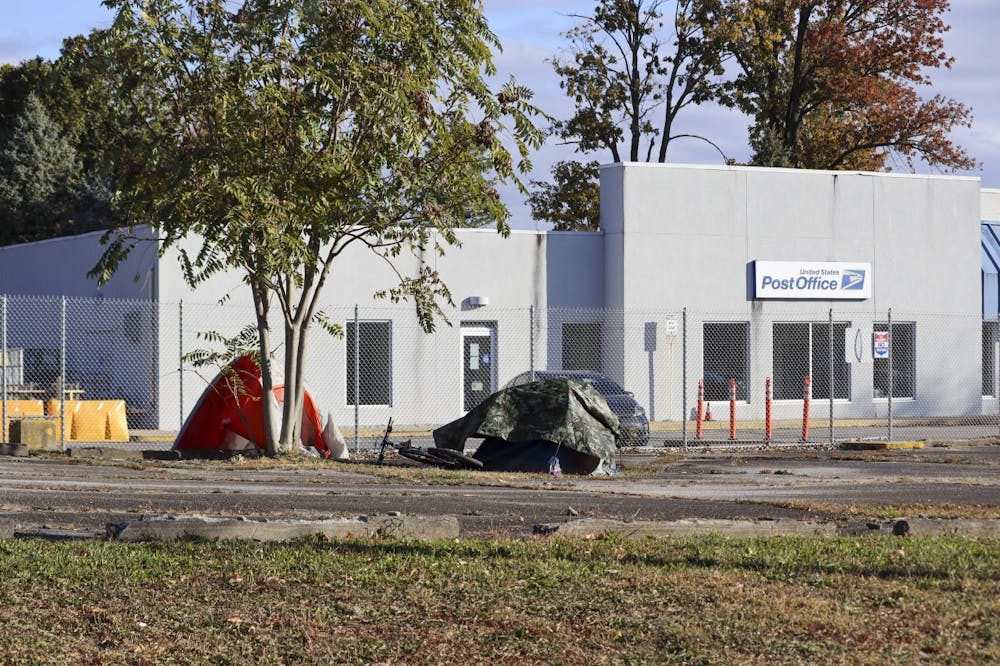Police and county officials, along with a hired firm from Indianapolis, cleared an unhoused encampment Oct. 6 off public Monroe County land south of Second Street. This removal is one of several in the past year as the city and county has continuously cleared camps, forcing those who are unhoused to relocate.
Concerns about health and safety
Monroe County Attorney Jeff Cockerill said the county has an ordinance that prohibits camping on county property, allowing them to clear any camps in violation of this ordinance.
“The biggest reason we have that ordinance is because of the health and safety,” Cockerill said. “There is a lot of debris, a lot of trash, a lot of needles in the ground, so it’s a safety issue, and we have our youth services shelter close to there, so that was a concern.”
He said the county has obligations to the public health department and the businesses and residents near the camps. Removing the camps is not a solution to helping unhoused individuals, but he said there are no other alternatives except to force them into shelters they would rather not stay in.
Related: [Heading Home organization outlines plan to fight homelessness in Bloomington]
Bloomington community member Jesse Reach has been experiencing homelessness for four years.
He said there are unhoused camps with trash and needles, but most of the camps bag their trash. However, there is no place for anyone to dispose of their trash, Reach said. Having designated places to dispose of trash for those who live in the camps would help keep the camps clean, he said.
“We can keep it a lot nicer and a lot neater,” Reach said. “People would respect us a little more and not want to run us off so much.”
He said offering more housing options can solve the issue of unhoused encampments having too much trash, which can lead to health and safety concerns.
“If they want less of what they’re complaining about, then we need more housing because once we have an apartment building, we have a dumpster to take our trash to,” Reach said.
As of August 2022, there are less than 10% of rentals that are under $1,000 a month, and only 2% of rentals that are under $700 a month in Bloomington, according to the H-T.
Ensuring there are enough shelters and housing
Cockerill said the county does not currently have a lot of resources to provide for people without housing. Most of the resources they do have been given to their partner with United Way. He said a third-party nonprofit organization like United Way has a better perspective on helping people experiencing homelessness than the county does.
Reach has lived in unhoused camps and shelters, but he is now moving into Crawford Homes. As a part of Beacon, Inc. , Crawford Homes is a nonprofit organization that provides support services to reduce hunger, poverty and the number of people experiencing homelessness in Bloomington.
Reach said he has applied for housing the past four years, and his application finally got approved just in time before he undergoes surgery for his heart problems.
Related: [Plans for affordable homes in northwest Bloomington hope to decrease the unhoused population]
“It took me getting really terminally sick for somebody to want to get on it and help me get a place to stay,” Reach said.
Reach said having approved, designated areas to camp and stay warm while outside would help. Some people don’t choose to stay in the shelters because they know they will not be permitted due to alcoholism or other substance use issues, having a mental illness or having a pet. Reach said his dog is the only family he has, and it’s hard for him to go to shelters because he suffers from social anxiety.
During his time living in shelters, he was kicked out because he was late coming back to the shelter by curfew a couple of times.
While Bloomington does have enough shelters for its unhoused residents, there is a shortage of shelters in surrounding regions, Forrest Gilmore, executive director of Beacon, Inc. said. There is also a shortage of affordable housing in the free to $400 rental range, he said.
How to help
Gilmore said public land has a special obligation to protect people’s rights and removing people from public land is a violation of their basic rights.
“Homelessness is dangerous and difficult, and displacing someone makes it more dangerous,” Gilmore said.
He said the majority of individuals who are living on the street have been experiencing homelessness for a long period of time and or have some type of disability, if not multiple types, which can lead to high death rates.
“We’re dealing with people with extraordinary levels of disability, so we need to meet them where they are, and often where they are is in extraordinary need of support and help,” Gilmore said.
He said there is always more to be done and he would like to see more funding. The community, not just the county, can start working together to provide affordable housing for people with low incomes and supportive services such as health care, recovery work, mental health care and basic life and survival skills, Gilmore said.
Three key things people can do to help support people experiencing homelessness would be to donate money to nonprofit organizations like Beacon, donate necessities such as clothes and hygienic products and volunteer their time at shelters, Gilmore said.




